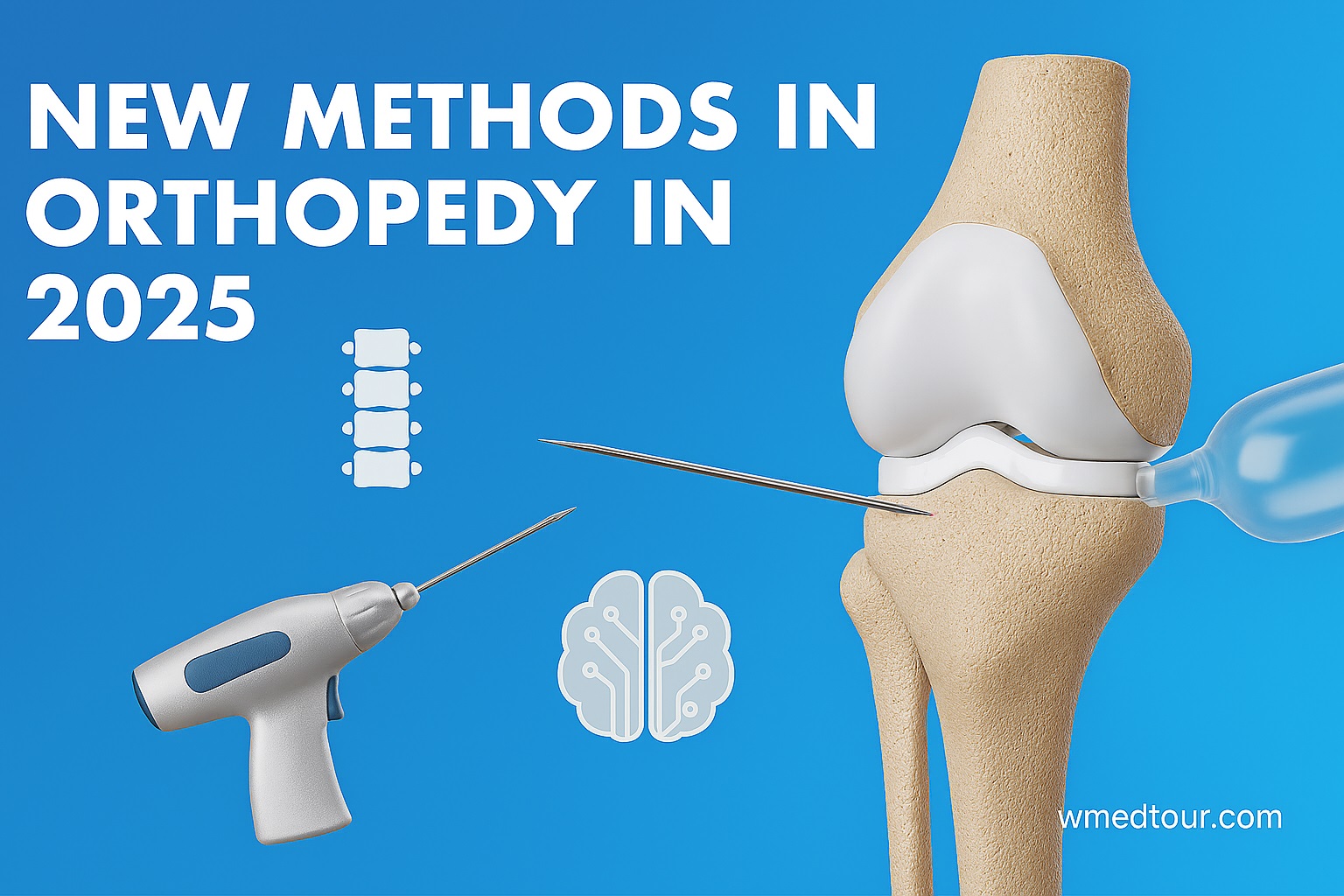Orthopedic Innovations in 2025: AI-Guided Surgery, Smart Implants & Robotic Precision
Executive Summary: The Future of Musculoskeletal Health
The field of orthopedics is undergoing a dramatic transformation driven by digital technology. By 2025, the standard of care is shifting away from generalized procedures toward extreme personalization and robotic accuracy. The key drivers of this change are **Orthopedic Innovations in 2025: AI-Guided Surgery, Smart Implants & Robotic Precision**. These tools empower surgeons with sub-millimeter accuracy, reduce complication rates, and accelerate patient recovery times. For individuals needing joint replacement, spine surgery, or complex fracture repair, these technologies offer outcomes that were simply unattainable a decade ago. We explore how artificial intelligence, sensory implants, and surgical robots are defining the new generation of orthopedic care and explain why leading global medical centers are now the best places to access this advanced level of treatment.
The Dawn of Robotic Precision in Orthopedics
Robotic-assisted surgery is arguably the most recognizable of the **Orthopedic Innovations in 2025: AI-Guided Surgery, Smart Implants & Robotic Precision**. It is fundamentally changing how procedures like total knee replacement (TKR), partial joint replacement, and complex spine fusions are performed. Contrary to popular belief, the robot does not operate independently; instead, it acts as a high-precision extension of the surgeon’s expertise.
During a procedure, the surgeon guides the robotic arm, which is programmed to operate only within the pre-defined boundaries set by the AI-guided plan. This critical safety boundary prevents the surgeon from making cuts outside the planned zone, guaranteeing unparalleled accuracy in bone preparation and implant placement. For instance, in a hip replacement, achieving the perfect angle for the acetabular cup is vital for joint longevity and preventing dislocation. The robot ensures this crucial alignment with greater reliability than the human hand alone.
Furthermore, the integration of real-time imaging (intraoperative fluoroscopy) with the robot’s navigation system allows surgeons to make immediate adjustments based on the patient’s anatomy during the procedure, a feature known as dynamic registration. Consequently, this blend of pre-planning and real-time guidance significantly minimizes soft tissue damage, which is the primary reason for post-operative pain and prolonged recovery periods. This innovation is transforming recovery from a painful, drawn-out process to a much quicker return to mobility.
Pros of Robotic-Assisted Surgery
- Enhanced surgical accuracy, often sub-millimeter precision.
- Reduced risk of implant malposition and subsequent complications.
- Smaller incisions lead to reduced pain and quicker recovery.
- Preservation of more healthy bone and surrounding tissue.
- Better long-term functional outcomes and implant longevity.
Cons of Robotic-Assisted Surgery
- Higher cost compared to traditional manual surgery.
- Requires specialized training and equipment, limiting its availability.
- Procedures may take slightly longer in some complex cases.
- Still relies entirely on the surgeon’s ability to plan and guide the process.
- The long-term (20+ year) data is still accumulating for the newest systems.
AI-Guided Planning: The Blueprint for Flawless Procedures
Before the robotic arm ever touches the patient, Artificial Intelligence sets the stage for success. AI-guided planning utilizes sophisticated algorithms to analyze patient data, including X-rays, CT scans, and MRIs, creating a precise, personalized surgical blueprint. This is an essential component of **Orthopedic Innovations in 2025: AI-Guided Surgery, Smart Implants & Robotic Precision**.
Initially, the AI system takes the complex 3D image data and models various surgical scenarios. It predicts the optimal size, placement, and alignment of implants, optimizing for the patient’s specific gait and biomechanics. This simulation capacity allows the surgical team to anticipate challenges and troubleshoot them virtually, long before the patient enters the operating room. For instance, for patients with severe deformity or prior failed surgeries, AI can identify anatomical landmarks that might be obscured, providing a clarity that traditional 2D imaging simply cannot match. Total hip replacement and complex spinal instrumentation benefit immensely from this pre-operative mapping.
Moreover, AI contributes to risk mitigation. By analyzing historical data from thousands of similar cases, the system can flag potential complications unique to the patient’s demographic or condition, such as bone density issues or ligament tension imbalances. Therefore, surgeons using this technology possess a level of foresight that drastically improves the success rate and overall safety of orthopedic surgery. This personalized pre-planning is the reason global orthopedic centers can confidently tackle highly complex cases referred from around the world.
Pros of AI Pre-operative Planning
- Creates a truly personalized surgical strategy for every patient.
- Significantly reduces surprises and technical difficulties intra-operatively.
- Predicts and optimizes long-term functional joint alignment.
- Lowers the rate of revision surgeries by ensuring initial accuracy.
- Provides superior visualization of complex or distorted anatomy.
Cons of AI Pre-operative Planning
- Requires additional pre-operative imaging (like CT scans) for data input.
- The system is only as good as the data it is trained on.
- Can add a small administrative cost and time to the pre-operative phase.
- Requires a powerful computing infrastructure not available everywhere.
- Data privacy and security concerns must be managed with care.
Smart Implants and Biologic Innovations
The innovation doesn’t stop when the surgery is complete; the devices themselves are becoming smarter. The development of **Smart Implants** represents a revolutionary component of **Orthopedic Innovations in 2025: AI-Guided Surgery, Smart Implants & Robotic Precision**. These implants, embedded with micro-sensors, monitor the healing process and provide objective, continuous feedback to the surgeon and patient.
Specifically, smart knee and hip implants can track crucial metrics: how often the patient walks, the range of motion achieved daily, and the load distribution across the joint. This objective data is invaluable. As a result, instead of relying solely on the patient’s subjective feedback during physical therapy, the surgeon receives actionable data. This allows for customized rehabilitation programs, minimizing the risk of re-injury or insufficient recovery.
Moreover, Biologics are rapidly advancing alongside technology. Orthopedic biologic innovations include sophisticated bone graft substitutes, injectable stem cell therapies, and concentrated platelet-rich plasma (PRP) used to enhance healing and regeneration. Consequently, these therapies are increasingly integrated into minimally invasive and arthroscopic procedures (Arthroscopic Surgery), promoting faster soft-tissue repair and reducing reliance on large-scale surgical fixation. This focus on maximizing the body’s natural healing capabilities alongside precise technological intervention marks a critical frontier in modern orthopedics (Orthopedic Surgery Guide).
Pros of Smart Implant Technology
- Provides objective, continuous post-operative performance data.
- Allows for personalized, data-driven rehabilitation protocols.
- Early detection of complications like infection or loosening.
- Remote monitoring reduces the need for frequent in-person check-ups.
- Increases patient engagement and adherence to recovery programs.
Cons of Smart Implant Technology
- Higher initial implant cost and potential maintenance costs.
- Managing the volume and security of the collected patient data.
- Requires patient compliance with external monitoring devices.
- Limited battery life (though rapidly improving with micro-batteries).
- Still a relatively new field, requiring regulatory standards development.
Comparison Table: Traditional vs. Advanced Orthopedics
Here is a comparison highlighting the differences between conventional, manual orthopedic surgery and the advanced, technology-driven methods defining 2025.
| Feature/Metric | Traditional Orthopedics (Manual) | Advanced Orthopedics (AI/Robotic) |
|---|---|---|
| Surgical Precision | Dependent on surgeon’s visual estimation and manual tools. | Sub-millimeter accuracy guided by robotics and AI mapping. |
| Implant Placement | Relies on intraoperative jig placement and X-ray checks. | Virtually planned alignment executed with robotic constraints. |
| Recovery Time | Moderate to long; higher soft tissue damage. | Often shorter; minimal tissue disruption and faster return to function. |
| Post-Op Monitoring | Subjective reporting from the patient; periodic X-rays. | Objective, continuous data from Smart Implants and remote sensors. |
| Complication Rate | Standard rate for implant loosening or malalignment. | Reduced risk of mechanical failure due to enhanced accuracy. |
Patient Journey: A Case Study in Robotic Knee Replacement
Meet Elias, a 65-year-old former athlete from the UAE suffering from severe osteoarthritis in his left knee. For years, he delayed surgery, fearing a long, painful recovery and potential misalignment that would prevent him from resuming his daily walks. He decided to seek out **Orthopedic Innovations in 2025: AI-Guided Surgery, Smart Implants & Robotic Precision** at a leading international hub known for its advanced technology (Orthopedic Centers in Turkey).
Elias’s Experience: From Diagnosis to Walking Freely
1. Pre-Op Planning: Elias received a specialized CT scan. An AI system analyzed this data to create a perfect 3D model of his knee, identifying the optimal implant size and alignment necessary to correct his specific varus deformity. The surgical team reviewed the plan, making minute adjustments virtually. This pre-planning saved time and guaranteed the precise positioning of the new joint.
2. The Procedure: The surgeon performed the total knee replacement using a robotic-assisted system. The robot guided the instruments, ensuring bone cuts were executed exactly as planned by the AI. This precision led to a minimally invasive approach, protecting the crucial surrounding ligaments and minimizing blood loss.
3. Recovery: Elias was up and walking with assistance the day after surgery. He experienced noticeably less pain compared to traditional accounts. His new implant, embedded with sensors, transmitted data on his progress. The surgeon, Dr. Amir, monitored Elias’s increasing range of motion remotely (find our doctors), adjusting his physical therapy program weekly based on objective metrics, not just Elias’s subjective feeling.
4. Outcome: Within four weeks, Elias was walking comfortably without a cane, exceeding the expected recovery timeline. The accurate alignment achieved by the robotic system ensures that his new knee is stable, pain-free, and built to last, allowing him to enjoy his retirement to the fullest. He now recommends this high-tech approach for anyone considering joint replacement.
Who is This For?
The latest **Orthopedic Innovations in 2025: AI-Guided Surgery, Smart Implants & Robotic Precision** are beneficial for a wide spectrum of patients. Specifically, this advanced care is ideal for:
- Joint Replacement Candidates: Patients needing Total Knee Replacement, hip replacement, or shoulder replacement who desire the highest level of accuracy and fastest recovery possible.
- Complex Cases: Individuals with severe deformities, significant bone loss, or those requiring revision surgery (a procedure to correct a prior failed surgery). AI planning is indispensable here.
- Spine Surgery Patients: Those undergoing spinal fusion (Spine Surgery) where screw placement accuracy is absolutely critical to avoid nerve damage. Robotic navigation greatly enhances safety.
- International Patients: Anyone seeking the best global standard of care, often combined with competitive pricing and streamlined patient services offered by leading medical tourism hubs like Dubai’s orthopedic centers.
Global Access and Medical Tourism
Access to these high-tech orthopedic procedures used to be a challenge, reserved for only a few privileged medical centers. However, the global medical tourism landscape has evolved significantly. Today, highly specialized hospitals in emerging medical hubs have invested heavily in the same state-of-the-art robotic systems and AI platforms found anywhere in the world. This is essential for delivering the promised standard of **Orthopedic Innovations in 2025: AI-Guided Surgery, Smart Implants & Robotic Precision**.
Ultimately, this democratization of technology provides patients with greater choice. Patients can now receive a robotic total hip replacement (THR) or a complex spine procedure from internationally trained, board-certified surgeons (Best Orthopedic Surgeon in Dubai) without the long waiting lists or prohibitively high costs often associated with older, established markets. Choosing a reputable global hub ensures access to cutting-edge technology and exceptional patient support, including travel and rehabilitation coordination.
In summary, the combination of AI, robotics, and smart implants is not just improving orthopedic surgery; it’s redefining the patient experience entirely, making recovery faster, more predictable, and safer than ever before. This forward momentum means that the best outcome is no longer a wish—it’s the expected standard of modern care.
Discover personalized treatment plans featuring AI and Robotic Orthopedic Surgery at world-class medical centers.




